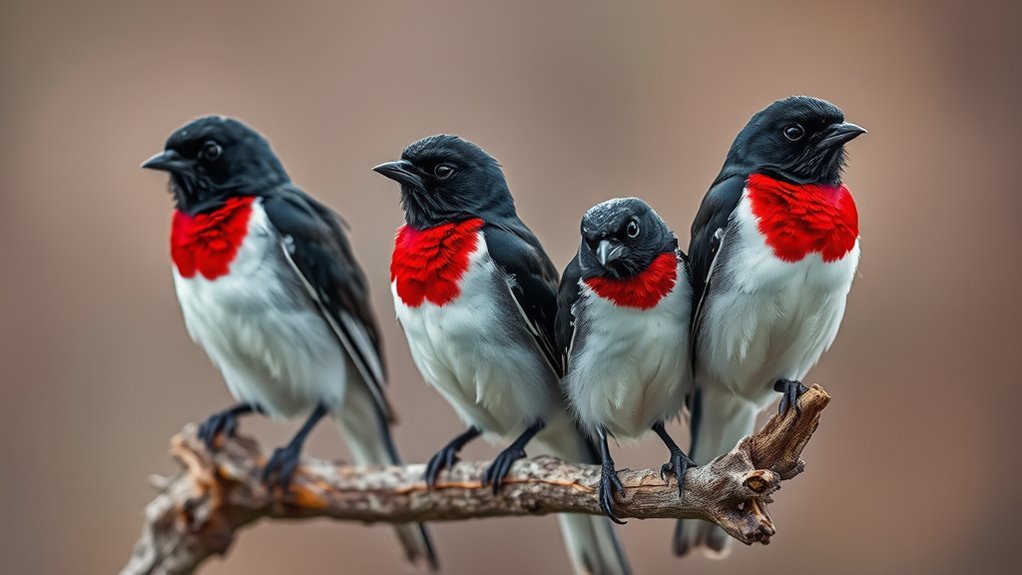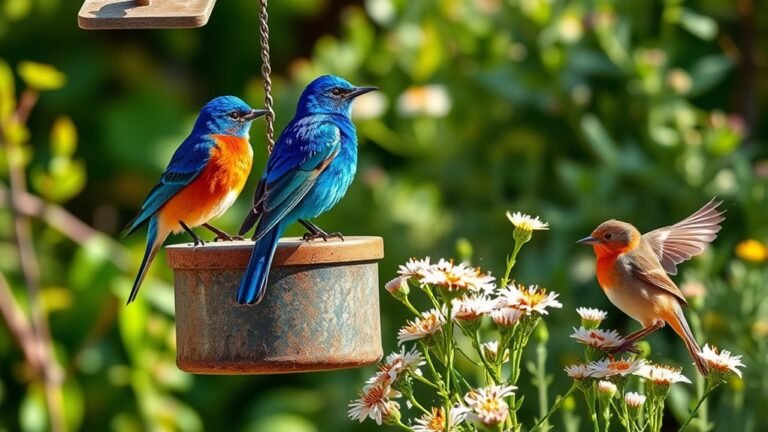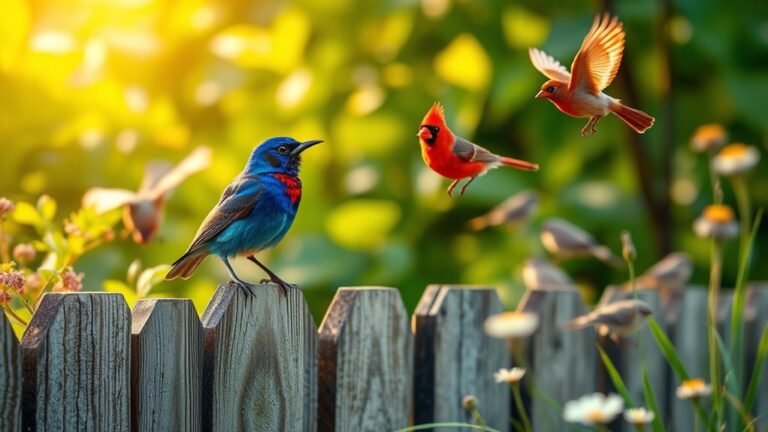Black and White Birds With a Red Chest: Identification Tips
Spotting black and white birds with a red chest can be both exciting and challenging during birdwatching. Key species to identify include the American Robin and the Rose-breasted Grosbeak. Look for their size, shape, and color patterns to help with identification. Knowing where these birds like to live can also improve your chances of spotting them. Let's look into the traits that differ between these birds and what to observe for accurate identification.
Key Takeaways
- Look for notable black and white feather patterns combined with a bright red chest to identify species like the American Robin or Rose-breasted Grosbeak.
- Pay attention to size and shape of the bird, as body structure varies among species with these color patterns.
- Seek birds in diverse habitats, such as woodlands and urban areas, where they find ample food and nesting options.
- Listen for distinct calls and songs that can help you identify species like the Red-breasted Nuthatch during your birdwatching.
- Observe seasonal behaviors and migration patterns, as these can inform you when and where to spot specific birds in your area.
Overview of Black and White Birds With a Red Chest

Identifying black and white birds with a bright red chest can be a rewarding experience. These birds often display unique patterns and colors that catch the eye. The red chest often indicates mating or territory claims. This color serves a purpose beyond beauty; it helps you recognize different species and their roles in nature.
The black and white feathers can help birds blend into their surroundings or attract mates. The bright red stands out, inviting admiration and interest. Observing these striking color contrasts can enhance your appreciation for bird diversity.
By improving your birdwatching skills, you can connect with the birdwatching community, exchanging insights and experiences with others who share your passion.
Enjoy exploring the fascinating world of birds and their colorful characteristics.
Common Species to Look For
As you observe black and white birds with red chests, you may notice several common species. These birds vary by location but typically inhabit similar environments.
Here are three species to watch for during your birdwatching outings:
- American Robin: This bird often appears in urban areas and gardens. It's known for its beautiful song.
- Rose-breasted Grosbeak: You can find this bird in wooded regions. Its vibrant colors stand out against its black and white plumage.
- Red-breasted Nuthatch: This small bird is common in coniferous forests. It's identifiable by its distinct call.
Getting to know these birds will improve your birdwatching experience and boost your confidence in identifying them.
Enjoy the unique variations you find in different regions!
Key Characteristics for Identification

Identifying black and white birds with red chests requires knowledge of their characteristics. Start by noting their physical traits, such as size and shape.
These birds usually have a strong body and bill. Examine their color patterns; the contrast between black and white feathers can help you identify them. Look for bright, noticeable red chests, which stand out.
Also, observe the size and arrangement of their feathers, as this differs among species. Recognizing these features will improve your ability to identify these beautiful birds and increase your enjoyment of nature.
Habitat Preferences and Distribution
To spot black and white birds with red chests, understanding their habitat preferences and distribution is key.
These birds thrive in diverse environments that offer ample food and nesting options. You can find them in these locations:
- Woodlands – They favor areas with dense trees and shrubs, where they can hunt for insects and gather fruits.
- Wetlands – Marshes and swamps are excellent for finding food and nesting spots.
- Urban Areas – These birds adapt well and often visit parks and gardens, blending into human environments.
Knowing their preferred habitats can help you increase your chances of seeing them in your area.
Distinguishing Features Between Similar Species

To identify black and white birds with red chests, observe their size, markings, and sounds. Some birds look alike, making it tricky to tell them apart.
For example, the Eastern Towhee and the Red-breasted Nuthatch may seem similar, but the Towhee is larger and has a more vivid red chest. Check their wing patterns and beak shapes for further clues.
Their calls are also helpful—unique sounds can guide you to the correct species. By focusing on these features, you'll improve your birdwatching skills and connect better with nature and other bird lovers.
Seasonal Behavior and Migration Patterns
As you learn to identify black and white birds with red chests, keep an eye on their seasonal behaviors and migration patterns.
These birds migrate based on several key factors.
- Weather Conditions: Birds often move to warmer areas when temperatures drop. They prefer milder climates for survival.
- Food Availability: The presence of insects or fruits in their environment influences when they migrate. If food is scarce, they'll leave their current habitat.
- Daylight Duration: Longer days signal the birds to start migrating. Increased sunlight indicates it's time to leave their breeding areas.
Recognizing these patterns can improve your birdwatching and deepen your connection to nature.
Enjoy learning about their habits and watching their journeys!
Feeding Habits and Diet
Feeding habits and diet are key to the survival of black and white birds with red chests. These birds use specific feeding techniques in environments like woodlands and gardens.
They mainly eat insects, seeds, and berries, showing a wide range of food preferences. You may see them searching through leaves for insects or pecking at fruits with their strong beaks.
Their feeding strategies can change with the seasons based on what food is available. Understanding these habits can enhance your birdwatching experience and deepen your appreciation for their role in nature.
Breeding and Nesting Behaviors
Understanding the breeding and nesting behaviors of black and white birds with red chests is important for those interested in their conservation and observation.
These birds show clear breeding signals that are interesting to see.
Here are main points about their nesting habits:
- Nesting Sites: They build nests in tree branches or shrubs. They choose spots that hide them from predators.
- Egg Laying: They usually lay 3 to 5 eggs in each clutch. The incubation period lasts about 12 to 14 days.
- Parental Care: Both male and female birds help feed and care for the young until they can fly.
These simple details provide insight into the lives of these birds, making them a fascinating subject for bird watchers and conservationists alike.
Photography Tips for Birdwatchers
Capturing black and white birds can be a fulfilling task. To start, use a sturdy tripod and a telephoto lens. These tools help you take close-up shots without bothering the birds. Set your camera to a fast shutter speed to freeze their movement, especially when they fly.
Pay close attention to the lighting. Shooting during the golden hour, just after sunrise or before sunset, makes your photos look better. Use the rule of thirds to frame your shots for more interesting compositions.
Shooting in RAW format offers you more options for editing later.
Lastly, be patient and quiet. The less noise you make, the better your chances are of catching those stunning moments.
With practice and persistence, you'll create extraordinary bird photos. Enjoy the experience!
Resources for Further Exploration
To improve your skills in identifying black and white birds, use the following resources:
- Field Guides: Buy reliable field guides specific to your area. These books give clear descriptions, pictures, and notes on bird behavior.
- Birding Apps: Download birding apps. They help identify birds and allow you to track your sightings. Many apps include bird calls and maps that show where each species can be found.
- Birdwatching Communities: Connect with birdwatching groups online or offline. Talking with other birders can help you learn faster and gain tips from seasoned watchers.
These tools will make your birdwatching experience more enriching and enjoyable.
Happy birding!
Frequently Asked Questions
What Do These Birds Symbolize in Different Cultures?
Birds carry different meanings in various cultures. They often relate to myths and symbolize love, renewal, or protection. Many cultures view birds as links to ancestors or spiritual worlds. Understanding these symbols can deepen your insight into human beliefs and experiences.
Can I Attract These Birds to My Garden?
You can attract birds to your garden by adding bird feeders with high-quality seeds. Plant native plants that provide food and shelter. This creates a friendly space for birds. Make your garden inviting by ensuring there are places for them to rest and find meals. Enjoy watching the birds visit your garden!
Are Any of These Species Endangered?
Some black and white birds with red chests are endangered. It is important to support efforts that protect their habitats. You can help ensure they survive for future generations. Every action matters!
What Is the Best Time for Birdwatching?
The best times for birdwatching are early morning and late afternoon. During these times, birds are most active. This makes it easier to see their behaviors and interactions. Observing birds during these periods enhances your birdwatching experience. Enjoy the sights and sounds of nature during these moments.
How Can I Identify These Birds by Sound?
To identify birds by sound, pay attention to their unique songs. Listen for patterns, pitch, and rhythm. Compare these sounds to guides or apps. This will improve your skills and help you connect with birds better. Enjoy the experience of learning about these amazing creatures.

Hello, I’m Amelia White, the founder of birdsfanatic.com. As a lifelong bird enthusiast and spiritual seeker, I’ve always been fascinated by the mystical connections between birds and the human experience. On this site, I share my knowledge and insights into the symbolic meanings and spiritual significance of various bird species, exploring their roles in mythology, folklore, and cultural traditions. Join me on this journey into the world of birds, where we’ll discover the hidden wisdom and guidance that these magnificent creatures have to offer.






